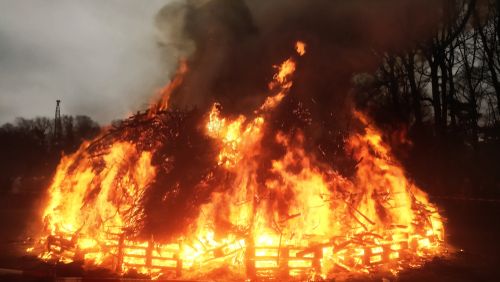 Funerals are primarily how we honor the lives of the deceased. They provide opportunities for those who knew and loved the dearly departed to not only celebrate that person’s life but also grieve together and comfort each other. The details of a funeral or last rite tend to become the responsibility of surviving family members or as specified by the dead person while alive. While burials and cremations are common ways of tending to the body, historically pyres were also ways to “send off” the dead in various cultures. Here’s what you should know about pyres.
Funerals are primarily how we honor the lives of the deceased. They provide opportunities for those who knew and loved the dearly departed to not only celebrate that person’s life but also grieve together and comfort each other. The details of a funeral or last rite tend to become the responsibility of surviving family members or as specified by the dead person while alive. While burials and cremations are common ways of tending to the body, historically pyres were also ways to “send off” the dead in various cultures. Here’s what you should know about pyres.
What Is a Pyre?
Strictly speaking, a pyre or funeral pyre refers to the structure on which a body is placed to be set on fire and burned. In effect, this ceremony is an open-air cremation. Often the structure is made of wood, which is generally flammable. The word “pyre” itself is an anglicization of the ancient Greek word for fire. In ancient societies, these rituals were used for offering burnt animal sacrifices to various deities. Historically, these death ceremonies have been a part of Roman and Viking cultures. For several thousands of years, adherents to the Hindu and Sikh faiths have executed pyres to honor the deceased, and they still do today.
Are Pyres Strictly Religious?
While Hindus and Sikhs still conduct funerals using pyres, this cremation approach has been used in secular contexts. Bonfires, for example, are often part of modern-day remembrances or acknowledgments of those who have passed on. Pyres have been used historically to cremate large numbers of bodies in some of humanity’s darkest moments, such as concentration camp prisoners in Nazi Germany. Large quantities of livestock, especially those infected by disease, have been disposed of using these open-air cremations.
What About Pyres in Western Cultures?
You may have seen pyres depicted in media as part of ancient cultures, such as that of the Vikings or Romans. Often these are shown as a body being set adrift on a raft to burn while floating away. If you’re wondering if that’s an option today, the short answer is often no. Open-air cremations are generally considered taboo and are illegal in most locations. Historically, these types of funerals were frowned on in European societies, but there are practical reasons as to why pyres are usually not allowed:
- Heat Needed: To properly cremate a body, you need to get it to a temperature of 2012 degrees Fahrenheit (or 1110 degrees Celsius) for at least two hours. It is difficult to generate fire with that intensity for a pyre. Even with modern crematorium practices, it’s still necessary to grind the bones afterward into powder.
- Body Disposal Laws: Many countries have strict laws on how bodies should be disposed of. Fires don’t burn hot enough or long enough to fully cremate a corpse. In the case of a pyre on water, it’s likely that the partially burned body would end up floating or washed up on shore somewhere. Imagine coming across the remains of a body that was set adrift down a river or creek!
- Environmental Concerns: The effects of pyres on the environment are significant. In India, the average open-air cremation requires six hours of burning and over a half-ton of wood. This results in considerable levels of deforestation, greenhouse gas emissions, air pollution and toxicity from ashes being thrown into the water.
Crestone, Colorado, is the only place where open-air cremation is legal in the United States. A maximum of 12 can be performed there each year, irrespective of religion or cultural traditions. As such, these pyres are limited to those who were members of that community.
While a funeral pyre might look like a cool sendoff in media, it is neither practical nor legal for most Americans. For now, you’ll have to make other arrangements for an alternative burial or funeral.
Add Your Comment